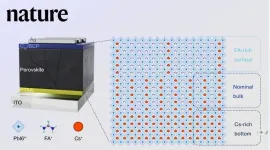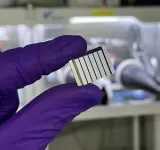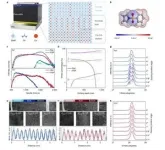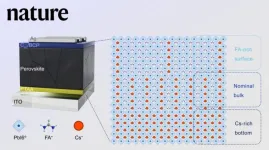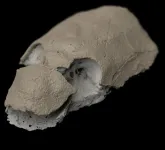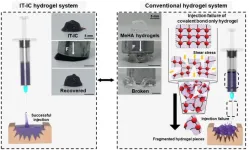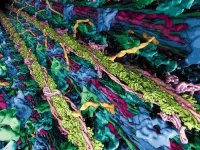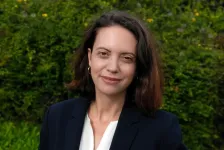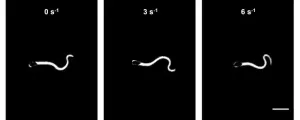(Press-News.org)
In a study published in Nature, researchers from the Hefei Institutes of Physical Science (HFIPS) of the Chinese Academy of Sciences have proposed a new and promising method of fabricating homogenized perovskite films for solar cells. The process involves inhibiting phase segregation caused by internal cation inhomogeneity to increase conversion efficiency to 26.1%, thus tying the existing record.
Their work was also featured as a Nature Editor’s Pick.
For solar cells, an important alternative energy source, the pursuit of higher conversion efficiency and the attempt to keep the cells table as long as possible are core issues that scientists and engineers all over the world are trying to address.
Lead-halide perovskite solar cells (PSCs) have been extensively studied due to their high efficiency, but a dramatic slowdown in the conversion efficiency growth rate of these cells can be seen. Notably, most previous studies of these cells have been limited to the surface, dopant, and component levels.
In contrast, PAN Xu, a solar cell scientist at HFIPS, and his team decided to look deeper—to the phase level.
Based on years of work in the field, the scientists realized that phase segregation inevitably takes place inside perovskite films, thus affecting or, more precisely, harming both the conversion efficiency and stability of the cells.
“We all know from previous work that cations in different groups are distributed inhomogeneously,” said PAN. “But how exactly these cations are distributed and the reasons behind it and how it affects efficiency remain unclear.”
To understand how cations behave in perovskite films, the researchers used experimental approaches to quantify how the cations FA+ and Cs+ were distributed vertically.
“Cs+ likes to aggregate at the bottom of the film, while a large amount of FA+ gathered at the upper interface of the film,” said PAN.
To verify this, they carried out further work by studying distribution in the crystalline phase. These experiments all agreed well with each other. The team was thus the first to clearly observe out-of-plane inhomogeneous distribution in a laboratory experiment.
Nevertheless, the researchers also wanted to know the reason for this distribution pattern and what to do about it. So they conducted an in-situ test to determine the exact mechanism behind this inhomogeneity.
“Then we found that cations in different groups crystallize and transform at very different rates,” said PAN, who believed this was the reason for the inhomogeneity. Once the researchers identified the key problem, they proposed a strategy of using 1-(Phenylsulfonyl)pyrrole (PSP) as an additive to make up for the difference in crystallization and phases transition rates in order to produce homogeneous films.
The researchers were pleased to see a significant increase in conversion efficiency to 25.8% under third-party certification. What’s better, the cells showed long-term, good stability, with conversion efficiency remaining as high as 92% of the original value even after 2,500 hours of maximum power point tracking.
According to public reports, this ties the record in conversion efficiency. All in all, PAN and his team’s work on phase optimization for solar cells suggests a promising technological path for improving solar cell conversion efficiency and stability.
END
In a study published in Nature, researchers from the Hefei Institutes of Physical Science (HFIPS) of the Chinese Academy of Sciences have proposed a new and promising method of fabricating homogenized perovskite films for solar cells. The process involves inhibiting phase segregation caused by internal cation inhomogeneity to increase conversion efficiency to 26.1%, thus tying the existing record.
Their work was also featured as a Nature Editor's Pick.
For solar cells, an important alternative energy source, the pursuit of higher conversion efficiency and the attempt to keep the cells table as long as possible are core issues that scientists and engineers all over the world are ...
A new analysis of the bones and muscles in ancient fish gives new clues about how the shoulder evolved in animals – including us.
The shoulder girdle – the configuration of bones and muscles that in humans support the movement of the arms – is a classic example of an evolutionary ‘novelty’. This is where a new anatomical feature appears without any obvious precursors; where there is no smoking gun of which feature clearly led to another.
The new research, which draws together a range of evolutionary investigation techniques including fossils, ...
In a recent publication in the journal Nature, researchers from the Institute of Basic Science (IBS) in South Korea have made significant strides in biomaterial technology and rehabilitation medicine. They've developed a novel approach to healing muscle injury by employing “injectable tissue prosthesis” in the form of conductive hydrogels and combining it with a robot-assisted rehabilitation system.
Let’s imagine you are swimming in the ocean. A giant shark approaches and bites a huge ...
Atrial fibrillation, heart failure and stroke – hypertrophic cardiomyopathy can lead to many serious health conditions and is a major cause of sudden cardiac death in people younger than 35. „The heart muscle is a central engine of the human body. Of course, it is easier to fix a broken engine, if you know how it is built and how it functions”, says Stefan Raunser. “At the beginning of our muscle research we have successfully visualized the structure of the essential muscle building blocks and how they interact using electron cryo-microscopy. However, these were static images of proteins taken out of the living cell. They only tell us little ...
Peptides are biomolecules formed when two or more amino acids that perform key functions in the human organism, such as hormones, neurotransmitters, painkillers and antibiotics, bind together. For this reason, they are much studied and used by the pharmaceutical industry, for example.
A study conducted by scientists in the Department of Biophysics at the Federal University of São Paulo's Medical School (EPM-UNIFESP) in Brazil identified significant changes in the physicochemical properties of peptides during a spontaneous process of chemical change called pyroglutamination.
Pyroglutamination is a modification resulting from spontaneous conversion ...
Amsterdam, November 1, 2023 – The Korean Society for Molecular and Cellular Biology (KSMCB), one of the largest and most prominent academic societies in the field of life sciences in Korea, and Elsevier, a leader in information and analytics for customers across the global research and health ecosystems, are pleased to announce a new partnership to publish Molecules and Cells, the flagship journal of KSMCB. This English-language publication will be hosted on Elsevier’s industry-leading online platform of peer-reviewed literature, ScienceDirect, beginning January 1, 2024. Continuing ...
In nature, swarms can accomplish amazing things. Schools of fish can more efficiently find food and migrate. Flocks of birds can confuse predators. Bees, ants, and termites can work together to feed, defend and build their colonies.
Robotics researchers have long been trying to harness this ability to explore environments, capture objects and build structures using robot swarms.
“But the problem of how do we efficiently control all those robots is still unsolved,” says David Saldaña, an assistant professor ...
The Association of Universities for Research in Astronomy (AURA) is pleased to announce the appointment of Dr. Jennifer Lotz as the Director of the Space Telescope Science Institute (STScI). Dr. Lotz will begin her five-year appointment as STScI Director starting February 12, 2024. Previously, Dr. Lotz was the Director of the International Gemini Observatory which is operated by NSF’s NOIRLab, and managed by AURA.
“Dr. Lotz is a science driven, accomplished leader,” said Dr. Matt Mountain, President of AURA, which manages STScI on behalf of NASA. “Jen’s passion for the Institute’s mission, to enable the ...
Sperm can modulate their energetics by regulating their flagellar waveform—how the sperm oscillate their tails—in order to adapt to varying fluid environments, potentially optimizing their motility and navigation within the reproductive tract. This research is reported in a study publishing November 1 in the journal Cell Reports Physical Science.
“Our approach allowed us to investigate how variations in viscosity and shear rates affect sperm behavior at the single-cell level, which was not possible using traditional methods,” says senior study author Reza Nosrati of Monash University.
Biochemical and biophysical cues within the reproductive ...
Women with atrial fibrillation (AF) undergoing a procedure called pulsed field ablation (PFA) have just as good outcomes as men with AF undergoing the same procedure, according to a large-scale international study led by the Icahn School of Medicine at Mount Sinai.
This study is the first to compare sex outcomes for AF patients undergoing PFA, which is a new technology and the latest ablation modality that can be used to restore a regular heartbeat. The results also show PFA is safe and just as effective for men as for women. Findings were published October 5 in JAMA Cardiology.
“These results are important, as ...
